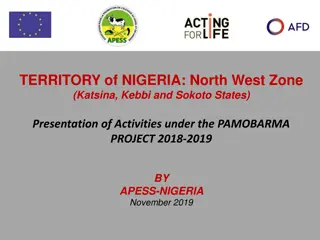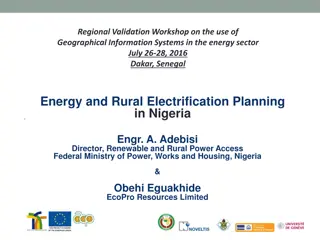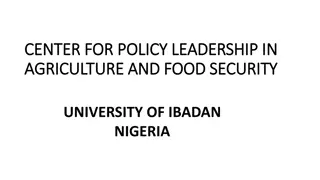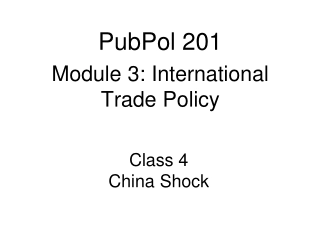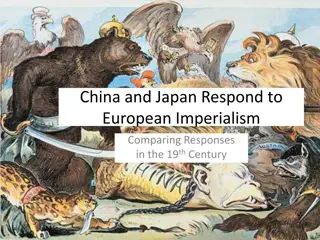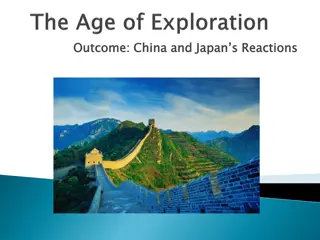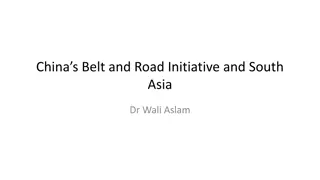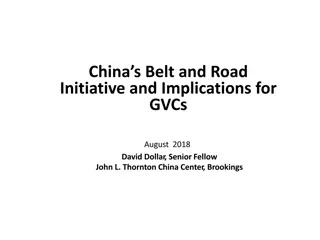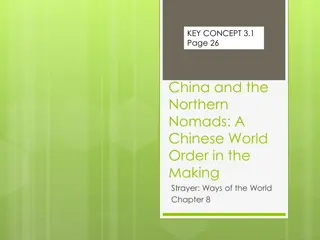NIGERIA/CHINA JUNCAO TECHNOLOGY CENTER
The Nigeria-China Juncao Technology Center explores the applications of Juncao technology and its contribution to achieving sustainable agriculture and the Sustainable Development Goals in Africa. Despite Nigeria's significant agricultural sector, challenges persist such as a widening agricultural trade deficit. Agriculture remains a vital sector in Nigeria, employing a large portion of the labor force and contributing to the nation's GDP. The innovative Juncao technology offers potential solutions to enhance agricultural productivity and sustainability in Africa.
- Juncao Technology
- Sustainable Agriculture
- Nigeria-China Collaboration
- Agricultural Development
- Africa
Download Presentation

Please find below an Image/Link to download the presentation.
The content on the website is provided AS IS for your information and personal use only. It may not be sold, licensed, or shared on other websites without obtaining consent from the author. Download presentation by click this link. If you encounter any issues during the download, it is possible that the publisher has removed the file from their server.
E N D
Presentation Transcript
NIGERIA/CHINA JUNCAO TECHNOLOGY CENTER APPLICATIONS OF JUNCAO APPLICATIONS OF JUNCAO TECHNOLOGY AND ITS CONTRIBUTION TO THE TECHNOLOGY AND ITS CONTRIBUTION TO THE ACHIEVEMENT OFSUSTAINABLE AGRICULTURE ACHIEVEMENT OFSUSTAINABLE AGRICULTURE AND THE SUSTAINABLE DEVELOPMENT GOALS IN AND THE SUSTAINABLE DEVELOPMENT GOALS IN AFRICA AFRICA Dr. Lawandi Ibrahim Datti (PhD) Nigeria-China Juncao Technology Centre December, 2023
Prof Lin ZhanXi Inventor of Juncao Technology
Nigerias main agricultural statistics 22% 36% N40bn The share of agriculturalcontribution The agricultural sector remains the largest Only about N40 billion was earmarked by to GDP as at Q1 2020 stood at employer in Nigeria, employing more than 36% the government for agricultural research and approximately 22%. of the labour force development (R&D) in 2022 >80% 0.27 hp/hectare 1.8% More than 80% of Nigeria s farmers Nigeria s tractor density is put at 0.27 hp/ Agriculture budget represents 1.8% (or N183 are smallholder farmers (SHFs). These hectare which is far below the FAO s billion) of the total 2022 budget size. This numbers accountsfor 90% of Nigeria s recommended tractor density of 1.5 hp/ hectare. significantlyfalls short of the 10% specified agriculturalproduce in the Maputo Declaration. N689.7bn N3.35trn N22.8trn Nigeria s agricultural trade deficit In four years (2019 2022), Nigeria s Nigerians spent about N22.8 trillion on food widened by N689.7 billion in 2021 cumulativeagricultural imports stood at N3.35 items in 2022, representing more than half compared to N549.3billion in 2022. trillion, four times higher than the agricultural (56.7%) of the total household expenditure of export of N803 billion within the same period. N40.2 trillion
Current Situation of Agriculture in Nigeria Agriculture is broadly divided into four sectors in Nigeria crop production, fishing, livestock and forestry. Crop production remains the largest segment and it accounts for about 87.6% of the sector s total output. This is followed by livestock, fishing and forestry at 8.1%, 3.2% and 1.1% respectively. Agriculture remains the largest sector in Nigeria contributing an average of 24% to the nation s GDP over the past years (2017 2022). In addition, the sector employs more than 36% of the country s labour force, a feat which ranks the sector as the largest employer of labour in the country. 25.2 25.1 25.1 24.5 23.3 23.1 22.9 22.0 Agriculture's contribution to GDP (%) 2015 2016 2017 2018 2019 2020 2021 2022* Source:NBS,PwC analysis
Nigerias agricultural trade deficit continues to widen amid government s push for self-sufficiency in the sector In four years (2018 2022), Nigeria s cumulative agricultural imports between 2018 and 2022 stood at N3.35 trillion, four times higher than the agricultural export of N803 billion within the same period. The share of agriculturein Nigeria s total export earnings remains small compared to crude oil exports. For instance in 2019, agricultureaccounted for lessthan 2% of total exports relativeto crude oil (76.5%). Nigeria's agricultural trade (N' billions) 1,200 Nigeria s major agriculturalimports include wheat, sugar, fish and milk, while the main agriculturalexports include sesame seeds, cashew nuts, cocoa beans, ginger, frozen shrimp and cotton. 960 1,000 887 852 Sesame, cashew nuts and cocoa account for more than half of the nation s agriculturalexports. While wheat dominates agriculturalimports. 800 656 -N689.7bn Agriculturalexport declined by about 11% from N302.2 billion in 2018 to N269.8 billion in 2019. 600 Nigeria s agriculturalimports rose by 12.7% from N851.6 billion to N959.5 billion during the same period, the highest valueever recorded in the country. 400 302 270 Nigeria remains a net food importer the agriculturaltrade deficit has widened with imports exceeding exports by N689.7 billion in 2019 compared to N549.3 billion in 2018. 170 200 61 0 2019 2020 2021 2022 Import Export Source:NBS,PwC analysis
Agricultural Problems Lack of accessto finance Resource shortages Over the pastyears, Nigeria has dealt with very lowyields per hectare due to shortagesin the supplyof inputs such as seedlings and fertilisers as well as inadequate irrigationand harvesting systems, whichhinders productivityand yield rates. Althoughthe Nigerian government has provided several facilities throughthe Central Bank of Nigeria (CBN) such as the AnchorBorrower sProgramme to help providesmall- scale farmers with adequate financing, the farming industry still lacks adequate access to finance. 01 06 02 Violent conflict Due to the desertificationand water depletion in the northernpartof Nigeria, nomadic herdsmen are now shiftingtowardsthe south of the countryin search of grazing fields and water for their animals. Thishas resulted in violent conflictwith crop farmers in the south. Increased violence in the food producingstatesis causing decline in Nigeria s foodproductionoutput. Insufficient supplyto meet population growth and food demand With a populationof roughly200 million people, Nigeria s agriculturalproductivityis insufficient to meet the food demanded of its growing populationthusincreasing the demand and supplygap in Nigeria. 05 03 Outdatedsystemof agriculture Outdated methodsof agriculture such as the use of hoes and cutlasses reduce efficiency as these methods are costlyand time consuming. Nigeria s failure toadoptadvanced mechanised systems has reduced the quality of its agriculturalproducts. 04 Absence of value additionand supply-chainlinkages Nigeria focuses mostlyon food production,thusneglecting the processingand manufacturing segment of the value chain. The chain reactionthatarises fromshortagesof resources, lack of financing for small-scale farmers and inefficient transportsystems, exacerbatesthe development of food productionalong the value and supplychain
Desert encroachments in Nigeria Nigeria like some other countries of the world is experiencing various forms of environmental problems which range from oil spillage, flood, erosion, desertification among others. Desertification is one of the most glaring of these environmental hazards and the phenomenon has affected some states in the northern part of Nigeria, but the impact has been more glaring since the famine of 1971-1973 in this part of the country. By location, Northern Nigeria is situated in the semi arid areas with average annual rainfall or less than 600 mm bordering on the Sahara desert (Folaji, 2007)
Juncao Technology intervention to Nigeria Agriculture The National Engineering Research Centre for Juncao Technology of the Fujian Agriculture and Forestry University (FAFU) of China had developed Juncao technology (Jun meaning fungi, cao meaning grass), which allowed farmers in Nigeria to grow several types of nutritious mushrooms from dried, chopped grasses, without cutting down trees and damaging the environment. Such an environmental- friendly technology can help small-scale farmers and farming communities to develop a low-cost, commercial-scale mushroom cultivation industry that can provide sustainable livelihood for thousands. The main aim of Nigeria/China Juncao Technology Center is to help farmers in Nigeria to grow mushrooms from dried, chopped grasses, without cutting down trees and damaging the environment. In addition, the technology can also be used for producing cattle feed, methane gas and also minimize soil erosion to combat desertification and other agricultural produce. In addition, the technology can also be used for producing cattle feed, methane gas and also minimize soil erosion to combat desertification. In the long run, depending on local demands and the scale of production, it may also provide opportunities for exporting the mushrooms cultivated using the technology. The importance of capacity building of Nigerians is to enable the country to implement the 2030 Agenda for Sustainable Development and the SDGs is underlined and reiterated in the above-mentioned resolution very clearly.. The intervention aims to enhance knowledge and strengthen national capacities of Nigerians to improve their policies and programs supporting sustainable agriculture through the transfer of Juncao technology in order to promote productive activities, income generation and entrepreneurship especially among socially disadvantaged groups including farmers, women, youth and to effectively contribute to the achievement of the sustainable development goals (SDGs).
Presently Present Research on Comparative analysis of Nutrient and Microbial Population from the rhizosphere of Juncao Grasses Cultivated Under Semi Arid Soil In Nigeria
LAWANDI IBRAHIM DATTI DIRECTOR/RESEARCH EXPERTS NIGERIA-CHINA JUNCAO TECHNOLOGY CENTER Dattiibrolwn@gmail.com, 2488682139@qq.com Wechat: Datti1980, whatsapp: +2348034990865






